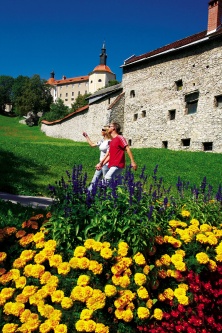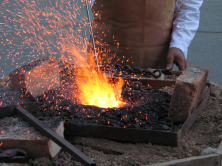KULTURA I UMJETNOST
Gorenjska’s characterful towns - Škofja Loka, Kropa, Tržič, Radovljica and Kranj – have interesting architecture and rich histories, while the region’s countryside boasts dozens of beautiful and historic churches.
Rural heritage, including numerous old farmsteads and hayracks, such as those at Studor near Bohinj, are nonetheless remarkable. The fortifications of the pre-WWII Rupnik Line above the Poljanska Valley are a reminder of old frontiers and the turbulent history of the 20th Century.
The long history of smelting in the region is marked by the surviving early-19th Century blast furnace in Železniki, culminates in Stara Sava, the former mill quarter of Jesenice and in Kropa near Radovljica.
A primer to any such journey through the history and development of Alpine Slovenia is perhaps best provided by the museum collections which today find their homes within the walls of a number of the region’s castles.
Castles

As a consequence of its spectacular location on the cliff above the lake, Bled Castle and its museum is one of this country’s most frequently visited tourist attractions, and presents local history from the era of the first settlers onwards.
Škofja Loka Castle, like Bled a most impressive crown to the town's veduta, also houses a museum which, in addition to housing archaeological, art history, craft and natural science collections, organises exhibitions and a variety of workshops.
The distinctly Renaissance Khislstein Castle is one of Kranj’s major attractions; through the centuries it evolved from a fortified manor adjoining the old town wall to the palatial home of the Khisl family, and today houses a portion of the Gorenjska Regional Museum collections.
Kamen Castle in Begunje, which used to be one of the most important possessions of the Ortenburg nobility, is the largest complex of fortifications in the region, though it is for the most part in ruins.
The 19th Century Zois Mansion in Stara Fužina near Bohinj was built for Žiga Zois (Sigmund Zois), a renowned industrial baron and patron of the arts and sciences.
Strmol Castle near Cerklje and the Renaissance Brdo Castle near Kranj are both used by the state to host diplomatic meetings and other inter-government events, but may also be visited upon prior arrangement.
Radovljica Mansion is the queen of Radovljica's architecture. In the old town of Radovljica it houses a magnificent Baroque hall, the Museum of Apiculture, and the Municipal Museum of Radovljica. In Baroque Hall concerts and other events take place.
Municipal and regional museums
Tržič Museum maintains technology and ethnography collection, as well as a local history exhibition.
Kranj Town Hall houses the major part of the Gorenjska Regional Museum and its permanent collections encompass fine art, archaeology and ethnography; of particular note is its gold and silver jewellery dating from the 5th and 6th century.
Upper Sava Museum in Jesenice lies within the town’s Stara Sava district, which is now preserved as an industrial heritage site and encompasses a most significant collection in relation to the region’s long and rich history of iron smelting: in addition to which there is a paleontological collection in the Bucceloni-Ruard Manor, an ethnographic collection in the Kasarna (‘barracks’ – once used as mill-worker’s housing) as well as a contemporary history collection in the Kos Manor.
Škofja Loka Museum presents the life of the in the river basin area of the two Sora rivers
in various prehistoric periods, the emergence and development of the medieval
Škofja Loka together with economic and cultural development of the city before industrialization.
The museum features a collection of eight traditional crafts and rich artistic
heritage as well as the collections of the painter Ivan Grohar and writer Ivan
Tavčar. The outdoor museum features Škropar house with a black kitchen.
Located in a picturesque manor house in the old centre,
Radovljica Municipal Museum presents the life and work of Anton Tomaž Linhart. It also collaborates with specialised smaller museums and galleries locally, including the
Museum of Hostages in Begunje. Housed in the Katzenstein Manor, in which some 10,000 Gestapo prisoners were once held, this museum preserves the memories of victims, the internees who perished or were put to death here during the Second World War.
Specialised museums and collections
Housed in a fine Baroque town house, Radovljica’s
Museum of Apiculture presents the history and distinctive features of beekeeping in Slovenia and encompasses a collection of decorative beehive panels; the adjacent architectural and gallery exhibitions in the decidedly late-Gothic
Šivec House are also of interest.
In Radovljica you can also visit the Gingerbread workshop museum, where you can observe the skilled staff produce little sweet surprises and presents, honouring age-old recipes and using antique tools.
The Triglav Museum Collection in Mojstrana relates the history of mountaineering in the Julian Alps, while the life of alpine herdsmen is displayed in Bohinj’s Pastoral Farming Museum which is located in a former cheese dairy.

A number of museum collections give an insight into old trades and crafts. The Foundry Museum in Kropa provides an overview of the development of smelting and iron working from the 15th to 19th Century, as well as nail-making during the 20th Century. An old foundry is also on display at the Železniki Museum which is located in a typical iron-worker’s house dating from the first half of 17th Century. In front of the museum is the massive form of a blast furnace reconstructed in about 1860, the only preserved one of its type in the country.
Žiri Museum (currently under renovation) keeps - among other exhibitions - shoe-making and lace-making collections, crafts typical to the area.
Other attractions
At Studor near Bohinj, as well as at the Ajdovski Gradec archaeological park above Bohinj, there are some groups of double-hayracks known as toplar. Below the town of Kranj are subterranean tunnels, excavated during World War II, while in Kropa, the first Slovenian town to be protected as an industrial heritage monument, one can follow the early development of iron smelting in Slovenia. Tržič and Radovljica are also listed as heritage sites.
A lot of locales with special features and characteristics can be accessed via marked thematic trails.
